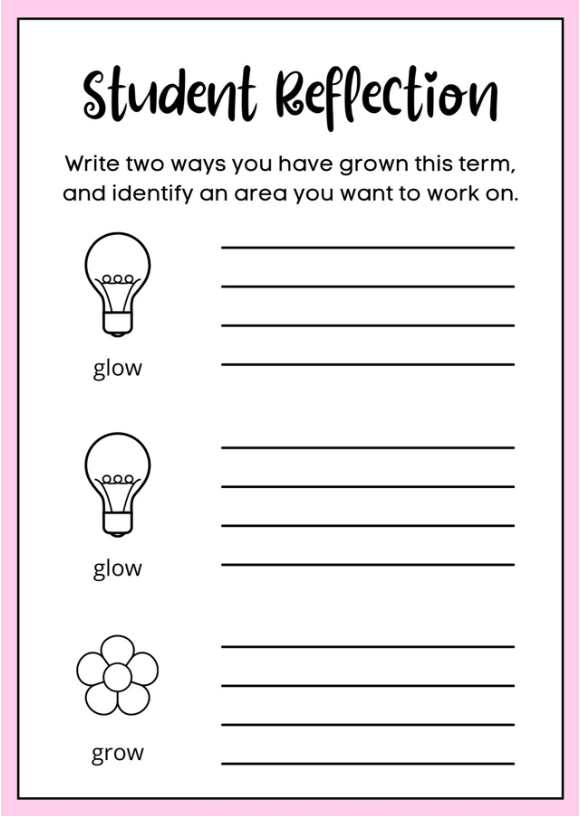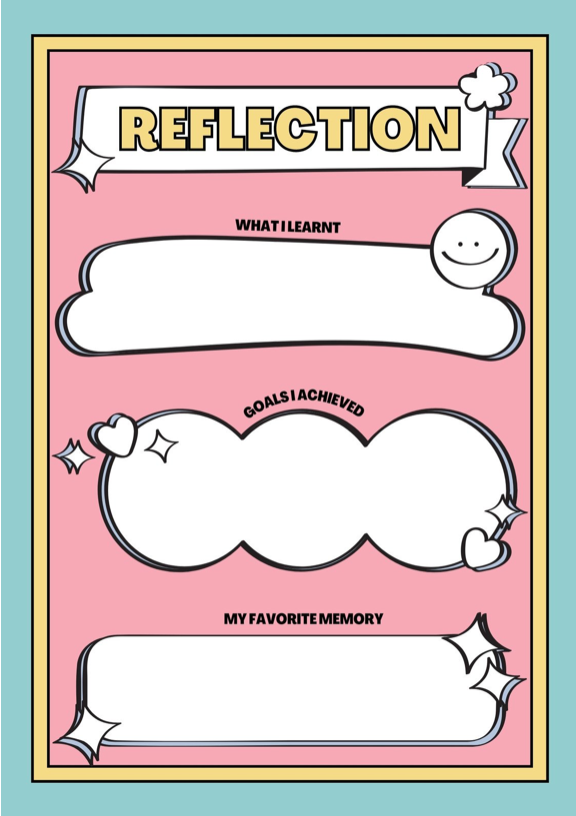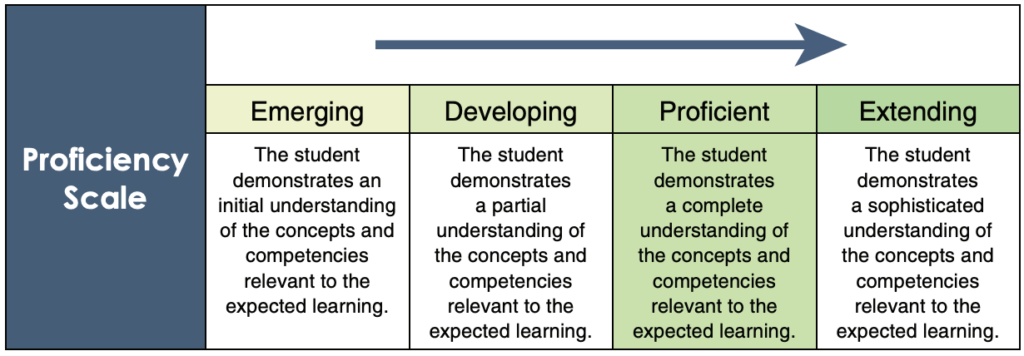Literacy Assessment Tool: Student Reflections
I absolutely love the idea of using student reflections as a summative assessment tool, as they allow the teacher to look at the students individual understanding and learning of the content in a concrete way. I also believe this tool is a great way for teachers to reflect on their own teaching, as the work serves as evidence, did the students understand the lesson, or did they not? And you can use this feedback to completely alter the unit for the next time you teach it, or to understand what to focus on for the upcoming unit.
*Canva has so many awesome templates for student self-assessment that you can use, make your own and alter to best suit your students and the content you are teaching! I highly recommend checking it out – here are some fun templates I found!


What is a student reflection?
From what I understand, a student reflection assessment tool is an activity or method to help students reflect on their own personal learning. It can be either formative or summative, meaning it can be integrated into a lesson at any point to track students learning (formative) or used as a final piece of evidence for students learning (summative.) The assessment tool can also be very open and altered for any grade, which is one of the reasons I love it so much! You can ask as many questions as you feel is appropriate and construct those questions however you may like (some helpful example questions), but making sure they connect to the overall unit and goal you have set out for the students. Some example questions if you have just finished a literacy book unit could be, “what is the message of the story? what character do you connect to most and why? etc.” The main goal of the assessment tool is to make sure you are encouraging students to think critically about what they have learnt throughout the unit and are going to reach the intended goal you have set out for them (which could be linked to the Grade 3 English Language Arts Big Idea “stories and other texts help us learn about ourselves, our families, and our communities.”)
The reasons I would use student reflections as an assessment tool…
The reason I would integrate student reflections into my lessons and use them as an assessment tool is because I think they really show students understanding of the unit and allow them to think critically. I also love that you can alter the questions to best suit the grade level you are teaching or even alter them to best suit your classes needs. This method also links to the Core Competency “Thinking – Critical and Reflective Thinking,” especially Profile 3 “I can ask questions and consider options. I can use my observations, experience, and imagination to draw conclusions and make judgments” (BC Curriculum.) I believe that by incorporating student reflections into my teaching practice, I can better support my students learning and growth, while also keeping the questions engaging and relevant to the students.
How I would use student reflections and when I would use them
I would use student reflections as both a formative and summative assessment tool. I would have students do a student reflection nearing the middle of the unit to check their understanding of the unit so far, then again at the end. This allows me as the teacher to see if I need to slow down and go over some content again or carry on as is. It also allows myself and the student to see their progress from the middle of the unit to the end.
I would probably start this assessment tool at the grade level 3 as the English Language Arts curriculum states that by this grade they are focusing on writing processes, legible handwriting, sentence structure, conventions and also communicating using sentences and most conventions of Canadian spelling, grammar, and punctuation (BC Curriculum.) I would then carry this assessment tool on from grade 3 and use it for the following higher grades as I feel all students, in all grade levels would benefit from personal writing reflections. Additionally, for students that may struggle with writing they could still participate in this, as this assessment tool can be done in so many different ways and forms. The students would record themselves answering the questions through audio or video recording or they could draw a picture then describe the picture to you.
Reference
Curriculum. (n.d.-a). https://curriculum.gov.bc.ca/
Student Reporting Policy (BC)
The Student Reporting Policy in BC is an in depth document that contains all the information you need to know about K-12 student reporting, gathering evidence of learning and communicating student learning.
Proficiency scale

The Proficiency Scale is a four-point scale used to communicate how the student is doing in all subject areas and is used in correlation with evidence of students’ learning, which will highlight why the student is placed in the specific category. The proficiency scale is used in both written Learning Updates as well as the Summary of Learning that is presented at the end of the school year (Unpacking the Proficiency Scale- Support for Educators). This scale is used in grades K-9 and then switches to letter grades and percentages when the students enter grades 10-12.
I really enjoy that this scale focuses on helping and challenging students in their learning journeys. If a student continues to fall under the emerging category it does not mean they are “failing” it just indicates that the student needs more support and/or there is more evidence needed (Unpacking the Proficiency Scale – Support for Educators.) On the other side of the scale, if a student falls under the extending category it does not mean it is the end of the road for them, it means the student is scoring above learning standards and can be challenged to extend their thinking and learning even more. The Student Reporting Policy states that the goal for all students is to reach proficient on the Proficiency Scale!
Frequency of reporting
There are five different sets of reporting for students learning throughout the school year. There are four learning updates, the first two are called “Written Learning Updates” which are reports that are sent out to caregivers and students that contain communication and evidence of students learning in all subject areas and highlight what the students are currently learning (linking to the learning standards – BC Curriculum.) It also provides feedback (student strengths and stretches), information regarding the students attendance and any student self-assessments or reflections. This report uses the proficiency scale and highlights where the student is currently standing on that scale for each subject. The same goes for grades 10-12, the only difference being that they receive letter grades and percentages. Then there are also two informal learning updates, this could be done through open-houses, parent teacher student interviews as well as sharing students learning through online classrooms such as Seesaw.
The last report that is done at the end of the school year is called a “Summary of Learning” which is sent out to the caregivers and students, providing them with an overall summary of the students learning. This report contains all the same information as the other two previous reports, it is just more of an overall summary of the year.
References
K-12 student reporting policy. (n.d.). https://www2.gov.bc.ca/assets/gov/education/administration/kindergarten-to-grade-12/k-12-student-reporting-policy-communicating-student-learning-guidelines.pdf
Unpacking the proficiency scale- support for educators. (n.d.-b). https://www2.gov.bc.ca/assets/gov/education/administration/kindergarten-to-grade-12/unpacking-the-proficency-scale-support-for-educators.pdf
Examples of a student report card comment for English Language Arts:
Context: Below I have constructed a report card comment I would use for a grade 2 student who has scored “proficient” in English Language Arts (2). This report card comment would be part of the “Written Learning Updates” that is sent out twice a year.
“Throughout this term, we focused on playing with language to help students explore its different aspects. Morgan actively participated in our UFLI lessons, demonstrating a strong understanding of fluency and foundational reading skills. With assistance, Morgan is starting to make personal connections to picture books. Moving forward, we’ll continue to work on her understanding of storybooks and texts by asking questions throughout and after the story to spark more critical thinking and communication.
In writing, Morgan demonstrates a proficient understanding of letter formation, sentence structure, and conventions by showing consistency in her writing. I encourage her to add more details to her daily journaling to further develop her storytelling skills. Next term, she will have practice adding details as we create our own stories.”
Context: For our course Reading Instructional Principles and Strategies, a peer and I constructed an English Language Arts report card comment from a scenario we got presented for a student who is developing.
“_____ is developing in term 2 for English Language Arts. _____ continues to gain confidence in our Guided Reading groups and works well and contributes towards the weekly activities that take place in those groups. _______ has been working on spelling lists for short and long vowel sounds. I encourage ______ to continue working on her at-home reading practice and the spelling lists that get sent home on Fridays. For the month of February we had a read-a-thon and I was impressed by Suzy’s courage to read beyond her comfort level. She really gravitates towards animal books. Moving forward I encourage Suzy to practice sounding out words, use her expression when reading and to slow down. I am very proud of how far Suzy has come, and I look forward to seeing her continue to grow in English Language Arts.”
Leave a Reply
You must be logged in to post a comment.